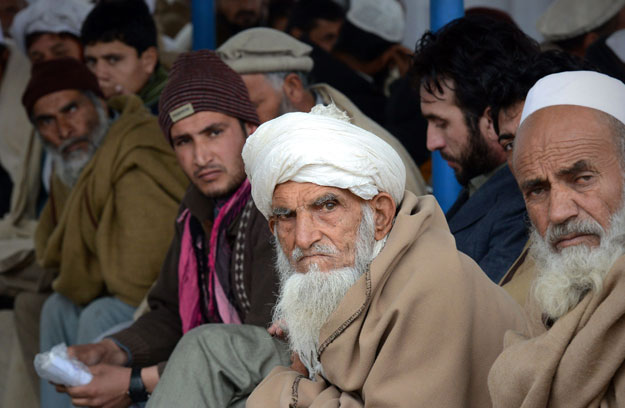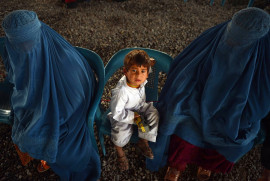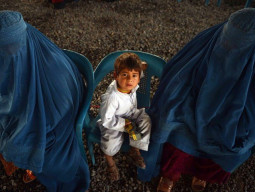
PESHAWAR:
It looks like an abandoned excavation site—odd-shaped bits and bobs poking out of the moors. It was an Afghan refugee settlement, a flourishing one at that, in the 90s when Afghans from as far as Badakhshan province came to seek shelter.
It is still referred to as the Kofi Annan Camp, named after the former secretary general of the United Nations who served from 1997 to 2006. The site is located in Urmar, near Shamshatu camp, on the boundary of Nowshera and Peshawar districts.
Culled of most of its infrastructure, all that remains is a towering seminary and overgrown graveyards sans epitaphs or any identifying markers. The schools and houses were demolished by the landowners once the refugees left. From bricks to blackboards, the owners left nothing behind.
Annan camp dwellers left in the year following 9/11. Some left for the promise of an Afghanistan under the Karzai regime; for others it was the departure of the former which prompted a steady withdrawal of aid organisations and a subsequent reduction in services for refugees.

The UNHCR puts the repatriation of Afghans in 2002 at 281,720 families or 1,565,095 individuals – the highest in the last 13 years.
But in the following years, hundreds of families had to return as the conflict in Afghanistan escalated and its fledgling economy took hit after hit. No one has the exact numbers of those returning to seek refuge; there are only estimates.
“We had no other option but to come back,” says Amir Hanfi, who once resided within the camp. “There was a shortage of food, jobs, and above all we had to stay alive,” he refers to the abysmal state of affairs in the neighbouring country. Hanfi was also once a registered refugee.
Pakistan’s host status
According to the UNHCR, Pakistan still has 76 refugee villages with more than 1.5 million registered refugees. Sixty-five of these villages are currently in Khyber-Pakhtunkhwa and the Federally Administered Tribal Areas. There are 10 in Balochistan, one in Punjab and none in Sindh. More then a million of these registered refugees—almost 67%--reside outside these villages.
The count of refugees without Proof of Registration cards poses another challenge as no definitive figures exist.
Even after the 2014 presidential elections, the situation in Afghanistan is still shaky. Opinions about the country’s progress might shift according to perspective; the country is still far from stable, making repatriation a slow process. Over the years, the number of Afghans going home has decreased. In 2014, only 12,991 registered Afghans went back.
Terse ties
There are increasing security concerns in Khyber-Pakhtunkhwa, which is home to almost 63% of registered Afghans. That, combined with the mass influx of families internally displaced from Pakistan’s tribal areas in the wake of military operations, the refugee status is honoured even less. There are increasing reports of mistreatment of Afghan citizens at the hands of the security apparatus in place.

In the months after the Army Public School was attacked in Peshawar in December, a more stringent approach has been adopted towards the Afghan population, raising concerns over human rights.
“They usually cannot differentiate between Afghan nationals with PoRs and those who are unregistered,” an official from the UNHCR told The Express Tribune, requesting anonymity.
With unregistered refugees being rounded up daily, the first three months have seen a gradual increase in the repartition, rather, deportation. Officials say around 10,600 refugees have returned this year; more than half were residing in K-P.

The tripartite commission, which includes Pakistan, Afghanistan and the UNHCR, in its recent meetings acknowledged the full reintegration will be a “gradual and challenging endeavour”. Not just that, the commission took up the challenge to conduct a census to determine the number of unregistered Afghan refugees throughout the country.
“The deciding body will include three members from each side – Pakistan has finalised two members,” confirmed an official, adding the process needs to be sped up. A draft will be finalised very soon, he added.
Worried faces can be seen on the Torkham border these days, those who are dependent on Pakistan and those who are leaving for Pakistan.

Source for map and dates: UNHCR
“I have lived my entire life in Peshawar” says Bacha Khan, “My sons are married to Pakistani women.” Bacha has stayed in Pakistan for over 20 years—almost a complete generation – and invested millions of rupees in different businesses. He now had to transfer his property to his daughters-in-law because he was an Afghan.
As he reluctantly put his affairs in order for the day he has to leave, others worry if they can even enter Pakistan. Inzar Gul, whose son was injured in a mine blast and needs to be taken to a hospital in Peshawar, is worried how many times he would be stopped before he can reach the hospital, or “Will I be allowed inside at all?”
Published in The Express Tribune, April 6th, 2015.
















































COMMENTS (1)
Comments are moderated and generally will be posted if they are on-topic and not abusive.
For more information, please see our Comments FAQ